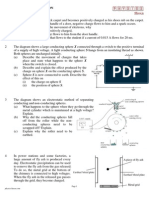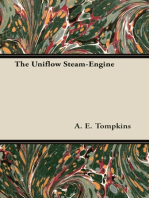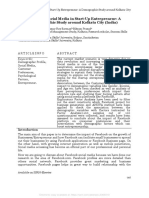Electronics Today 1986 02 OCR Page 0049
Electronics Today 1986 02 OCR Page 0049
Uploaded by
mikesoupCopyright:
Available Formats
Electronics Today 1986 02 OCR Page 0049
Electronics Today 1986 02 OCR Page 0049
Uploaded by
mikesoupCopyright
Available Formats
Share this document
Did you find this document useful?
Is this content inappropriate?
Copyright:
Available Formats
Electronics Today 1986 02 OCR Page 0049
Electronics Today 1986 02 OCR Page 0049
Uploaded by
mikesoupCopyright:
Available Formats
CIRCUIT SOLUTION
PWAyMan MOTOR
CONTROLLER
Following a brief mention in his column, Roger Amos expands on
the design of a railway modellers' motor controller which makes
comPromises without sacrifices.
Two techniques have dominated the design of elec- be living the controller a limited measure of
tronic controllers for the DC motors used in model intelligence.
trains and slot racing cars. Closed -Loop Control is The Right Track
an analogue technique in which the voltage at the con-
troller's output is compared with a control voltage - in its My approach was to employ both pulse width and
simplest form this may consist of a power Darlington with pulse amplitude modulation. I christened the resultant
technique 'Pulse Width and Amplitude Modulation'
its base bias taken from a pot and the load in its emitter
(PWAM). This acronym reminded me of the railway
circuit Pulse width modulation (PWM) is a digital jargon
technique in which the motor is fed pulses whose width
'permanent way' meaning track, so I called the
is varied to control speed. Normally some form of controller the 'PWAyMan'.
The PWAyMan delivers a square -wave PWM output
variable -duty -cycle multivibrator is used to provide an
butthe pulse amplitude is under direct closed -loop con-
input to a power transistor or thyristor. trol from the speed control. Pulse width is controlled bya
Both techniques have their pros and cons, summed up
in the table. An ideal controller would combine all the servo which compares the control voltage with the
best features and, so far as the laws of thermodynamics motor EMF. This is measured by a sample -and -hold
permit, eliminate all the problems. technique operating during the spaces between pulses.
Speed is indicated on a speedometer (Fig.1).
CLOSED -LOOP PWM
The controller has been extensively tested with a
AREA
variety of 00 -gauge locomotives and found to do al I that
starting/crawling good excellent was required. It gives fine control of speed with verytight
motor noise silent raucous speed compensation. A time contant of 2.5s in the servo
motor heating negligible a serious problem system makes the controller's response clearly visible -
output transistor runs hot runs cool as a train approaches a down gradient it accelerates
briefly and then on go the brakes! Give a train a helping
The ideal controller would also have another desirable pull on its way and the speedometer correctly kicks
property. Let's face it, most electronic controllers are before the train slows then resumes its original speed.
fairly dumb beasts. They deliver an output that is cap- Traction is improved since wheelslips automatically
able of giving quite fine control of motor speed, but result in counter -action. And impeding a train's pro-
apart from some form of overload protection, rarely do gress with a finger automatically raises the duty cycle so
they monitor the motor to see if it is doing what the the train struggles hard to get away.
operator intends. Yet it's not difficult to measure the Motor noise is quite unobtrusive at low speeds since
motor's speed and use this as an inputtoafeedbackloop pulse amplitude is then low. Similarly, no motor heating
to lock the motor speed to the control voltage. This has been observed, this being proportional to the square
would provide compensation for varying loads, when of the controller output voltage at low speeds when
the model negotiates a gradient ortight curve. We would motor EMF is negligible.
It has two disadvantages. Heat sinkage is still needed
COMPARATOR forthe output device and the circuit is rathercomplexfor
a controller. But there's always a price to pay for
DC
performance.
POWER
AMP
SAMPLE
Setting up
CONTROL 0
VOLTAGE CHOPPER AND
HOLD
It is essential for correct operation that the motor
EMF monitoring circuit works properly. The best way to
OUTPUT check this is by the speedometer. RV3 is used to calib-
rate this. Different locomotives may need different sett-
V
ings of RV3 until the meter reads 30 (a 1 00uA movement
SPEEDOMETER is assumed). Vary the train speed and you should find
that the meter reading varies in proportion. Stalling the
INTERVAL
loco should bring the reading to zero, as should lifting it
STROBE0 TIMER off the track. If you have other voltages on the track (such
as track circuit voltages), they may cause spurious
Fig. 1 Block diagram of the motor controller.
speedometer readings when there is no loco on the
track.
ETI FEBRUARY 1986 49
You might also like
- Electrician's Guide To The Building Regulations (3rd Edition)Document2 pagesElectrician's Guide To The Building Regulations (3rd Edition)fopoku2k2100% (1)
- Electrical Installation Calculations Volume 1: V. 1: by A. J. Watkins, Chris Kitcher, Christopher James KitcherDocument1 pageElectrical Installation Calculations Volume 1: V. 1: by A. J. Watkins, Chris Kitcher, Christopher James KitcherAli Raza KhanNo ratings yet
- Zs Values For Siemens 3RV20 May2012Document1 pageZs Values For Siemens 3RV20 May2012mpendletonNo ratings yet
- R56 GuidelinesDocument518 pagesR56 GuidelineslufrabaveNo ratings yet
- DCSBME604Document5 pagesDCSBME604bariNo ratings yet
- OCTOBER 24TH, 2019: in EnglishDocument4 pagesOCTOBER 24TH, 2019: in EnglishMuhammad Umar0% (1)
- A48EAX13x01 PDFDocument8 pagesA48EAX13x01 PDFPablosoNo ratings yet
- FG - Warehouse A - Rack - ReportDocument14 pagesFG - Warehouse A - Rack - ReportcihuyNo ratings yet
- BART Traction Power SimplifiedDocument4 pagesBART Traction Power SimplifiedNicholas Josefowitz50% (2)
- BS 5467 Armoured Power Cables, 600-1000VDocument9 pagesBS 5467 Armoured Power Cables, 600-1000Vrose chen0% (1)
- Plasma Cutting PDFDocument35 pagesPlasma Cutting PDFahmed100% (2)
- Weigh Bridge Typical Instrumentation Earthing Scheme and LayoutDocument1 pageWeigh Bridge Typical Instrumentation Earthing Scheme and LayoutChandan RayNo ratings yet
- Rowsley WoodsDocument4 pagesRowsley Woodsapi-302173014No ratings yet
- 2.temperature Control Using Siemens PLC LabDocument9 pages2.temperature Control Using Siemens PLC LabMunimNo ratings yet
- Service Info Weller EC 2002Document14 pagesService Info Weller EC 2002Adrian AdiNo ratings yet
- 2011 40 Autumn Wiring Matters Earthing PDFDocument8 pages2011 40 Autumn Wiring Matters Earthing PDFAbzi OzmanNo ratings yet
- Z5 DC Compound Wound MotorDocument13 pagesZ5 DC Compound Wound MotorFitri VongolaNo ratings yet
- Lsa 37 Shunt - 2 & 4 Pole: AlternatorsDocument20 pagesLsa 37 Shunt - 2 & 4 Pole: AlternatorsSubagyo Wahyu RiyadiNo ratings yet
- Download Complete 18th edition IET wiring regulations Explained and illustrated Scaddan PDF for All ChaptersDocument52 pagesDownload Complete 18th edition IET wiring regulations Explained and illustrated Scaddan PDF for All Chaptersdobarchaudy100% (1)
- Bs 7671 2018 Amendment 3 2024Document10 pagesBs 7671 2018 Amendment 3 2024Francisco José Murias DominguezNo ratings yet
- 2019 Grade 07 Mathematics Second Term Test Paper Central ProvinceDocument6 pages2019 Grade 07 Mathematics Second Term Test Paper Central ProvinceMelani RajapakshaNo ratings yet
- G99 Main Chapters v5 01082017Document116 pagesG99 Main Chapters v5 01082017Bruce CoxNo ratings yet
- Electrical Installations For NVQ Level 2 Third Edition by Christopher SheltonDocument5 pagesElectrical Installations For NVQ Level 2 Third Edition by Christopher Sheltonezse1No ratings yet
- 17th Ed 2382 Q Paper 2Document7 pages17th Ed 2382 Q Paper 2cfwong12345No ratings yet
- Inverter To Motor WiringDocument2 pagesInverter To Motor WiringGalih Wicaksono100% (1)
- Single Phase Induction Motors PDFDocument20 pagesSingle Phase Induction Motors PDFAmitava BiswasNo ratings yet
- BEAMA Guide Low Voltage Switch and Fusegear DevicesDocument25 pagesBEAMA Guide Low Voltage Switch and Fusegear DevicesAbel OliveiraNo ratings yet
- O Revision E&MDocument9 pagesO Revision E&MAlmas TalibNo ratings yet
- Cida Bulletin of Construction Statistics February 2021Document29 pagesCida Bulletin of Construction Statistics February 2021CrazyBookWormNo ratings yet
- Options For Rural Electrification of Arua District: BY Onzia Joseph O6/U/043/APD/GVDocument26 pagesOptions For Rural Electrification of Arua District: BY Onzia Joseph O6/U/043/APD/GVJoseph OnziaNo ratings yet
- Raymarine RadarDocument246 pagesRaymarine RadarDan DelfinoNo ratings yet
- Rotex PPDocument19 pagesRotex PPNILESHNo ratings yet
- BS4678 Class 3 TrunkingDocument3 pagesBS4678 Class 3 TrunkingKy Chau0% (1)
- Wifi Based SignallingDocument5 pagesWifi Based Signallingmwangowayne00No ratings yet
- BS 4568Document6 pagesBS 4568Shamoon ChaudhryNo ratings yet
- BS 7671 - WikipediaDocument4 pagesBS 7671 - WikipediahafizalidiNo ratings yet
- List 4 Importance of Electrical SafetyDocument2 pagesList 4 Importance of Electrical SafetyMohd RizwanNo ratings yet
- Maintenance of Brushes and Commutators 2 enDocument14 pagesMaintenance of Brushes and Commutators 2 enSavitha VinayNo ratings yet
- Handbook For Handi-Lift 7: CAMA Lift Aps. Ellehammervej 6 DK - 9900 FrederikshavnDocument21 pagesHandbook For Handi-Lift 7: CAMA Lift Aps. Ellehammervej 6 DK - 9900 FrederikshavnNick VanderauweraNo ratings yet
- Electric Motors: - Classification / TypesDocument24 pagesElectric Motors: - Classification / TypesBholendra ShakarNo ratings yet
- StatoEolien EnglishDocument31 pagesStatoEolien EnglishRaluca Drugan100% (1)
- Electricity at Work Regulations 1989Document3 pagesElectricity at Work Regulations 1989Lakshmanan SivalingamNo ratings yet
- A Simple Driver For VFD DisplaysDocument6 pagesA Simple Driver For VFD DisplaysDikdik Pribadi100% (1)
- En 50438 2013-BSDocument70 pagesEn 50438 2013-BSMario BreškiNo ratings yet
- Icetect17 PDFDocument2 pagesIcetect17 PDFskarthikpriyaNo ratings yet
- Altivar 31Document96 pagesAltivar 31Leyre Marcilla MartínezNo ratings yet
- Ctevt Electrical Engineering PDFDocument146 pagesCtevt Electrical Engineering PDFAvik PoudelNo ratings yet
- MOTOR - CONTROL - WIRING (MConverter - Eu) 2Document109 pagesMOTOR - CONTROL - WIRING (MConverter - Eu) 2Rommel Ledesma100% (1)
- Sabre 3008 WebDocument70 pagesSabre 3008 Webjchs2880No ratings yet
- Chapter No.:-01 Introuuction: Pulse-Width Modulation (PWM), Modulation (PDM)Document63 pagesChapter No.:-01 Introuuction: Pulse-Width Modulation (PWM), Modulation (PDM)Pooja BanNo ratings yet
- Constructional Project: 'FeaturesDocument2 pagesConstructional Project: 'FeaturesBimoo Chandra Bimantara PutraNo ratings yet
- AppNotes PortableOscillopes IM EasycaptureDocument2 pagesAppNotes PortableOscillopes IM EasycaptureMOHAMMAD ZAKIRNo ratings yet
- AVR With Dead TimeDocument26 pagesAVR With Dead TimegrittinjamesNo ratings yet
- Soft Starting Control of Single-Phase Induction Motor Using PWM AC Chopper Control TechniqueDocument4 pagesSoft Starting Control of Single-Phase Induction Motor Using PWM AC Chopper Control TechniqueMpumelelo NgcoboNo ratings yet
- The_Pulse_Width_Modulation_and_its_Use_in_Induction_Motor_Speed_ControlDocument4 pagesThe_Pulse_Width_Modulation_and_its_Use_in_Induction_Motor_Speed_Control2023pde5268No ratings yet
- ElecDocument31 pagesElecdeepanshumehalawat07No ratings yet
- Fault Detection and Fault-Tolerant Control of Interior Permanent-Magnet Motor Drive System For Electric VehicleDocument6 pagesFault Detection and Fault-Tolerant Control of Interior Permanent-Magnet Motor Drive System For Electric VehicleAnurag MishraNo ratings yet
- Servo Motor PDFDocument11 pagesServo Motor PDFNenad ŽivićNo ratings yet
- Vector ControlDocument5 pagesVector Controlapi-26587237No ratings yet
- !DOGA Standard For NEM PocketsDocument2 pages!DOGA Standard For NEM PocketsmikesoupNo ratings yet
- METALWORKDocument10 pagesMETALWORKmikesoupNo ratings yet
- Coping With ADHD Strategies Book Devon NHSDocument27 pagesCoping With ADHD Strategies Book Devon NHSmikesoupNo ratings yet
- Cognitive Behavioral Therapy Olivia TelfordDocument114 pagesCognitive Behavioral Therapy Olivia TelfordmikesoupNo ratings yet
- 02 Steve Griffiths The Simple Secret - Position SizingDocument20 pages02 Steve Griffiths The Simple Secret - Position SizingmikesoupNo ratings yet
- CMX Manual GenericDocument8 pagesCMX Manual GenericmikesoupNo ratings yet
- Zimo Decoder Catalog 2016 06 EnglishDocument40 pagesZimo Decoder Catalog 2016 06 EnglishmikesoupNo ratings yet
- Neodymium Magnets (Neo-Magnets) Are Extremely Strong. They Must Be Handled With Care To Avoid Personal Injury or Damage To The MagnetsDocument1 pageNeodymium Magnets (Neo-Magnets) Are Extremely Strong. They Must Be Handled With Care To Avoid Personal Injury or Damage To The MagnetsmikesoupNo ratings yet
- Nother Inning: Success Trading GroupDocument2 pagesNother Inning: Success Trading GroupmikesoupNo ratings yet
- Arc' A Combined DCC Auto-Reverse and Cutout ModuleDocument1 pageArc' A Combined DCC Auto-Reverse and Cutout ModulemikesoupNo ratings yet
- The Five Whys For Powerful Problem-SolvingDocument1 pageThe Five Whys For Powerful Problem-SolvingmikesoupNo ratings yet
- Visiting PDFDocument1 pageVisiting PDFmikesoupNo ratings yet
- Britannic Assurance - Moor Green Memories by Reg MonkDocument3 pagesBritannic Assurance - Moor Green Memories by Reg MonkmikesoupNo ratings yet
- Outcome Based Pedagogic Principles Pedagogic Principles For Effective TeachingDocument39 pagesOutcome Based Pedagogic Principles Pedagogic Principles For Effective TeachingAzhagesvaran TamilselvamNo ratings yet
- (14-19) 3B-Ch.11-Measures of Central Tendency - MCDocument4 pages(14-19) 3B-Ch.11-Measures of Central Tendency - MCsophia yeungNo ratings yet
- Impact of Social Media in Start-Up Entrepreneur: A Demographic Study Around Kolkata City (India)Document13 pagesImpact of Social Media in Start-Up Entrepreneur: A Demographic Study Around Kolkata City (India)Manika JainNo ratings yet
- Soal B.Inggris SMK XDocument8 pagesSoal B.Inggris SMK XTikaNo ratings yet
- Ficha Tecnica Valvula Mariposa Cuerpo H.O - Disco InoxDocument1 pageFicha Tecnica Valvula Mariposa Cuerpo H.O - Disco Inoxlaura giraldoNo ratings yet
- Mobile Healthcare ThesisDocument8 pagesMobile Healthcare Thesisjenniferalexanderfortlauderdale100% (2)
- Master Raspberry PiDocument55 pagesMaster Raspberry Pielvedin.zenicaNo ratings yet
- Numerical Heat Transfer, Part A: Applications: An International Journal of Computation and MethodologyDocument24 pagesNumerical Heat Transfer, Part A: Applications: An International Journal of Computation and MethodologyZahi AekNo ratings yet
- On Death and Dying by Elisabeth Kübler-Ross Was One of The Top Selling Books of TheDocument25 pagesOn Death and Dying by Elisabeth Kübler-Ross Was One of The Top Selling Books of Theeduardo aquinoNo ratings yet
- Role of Technology in Services Industry: Hotels & MotelsDocument14 pagesRole of Technology in Services Industry: Hotels & MotelsApurva_Agarwal_8218No ratings yet
- SM J200G Eplis 11Document10 pagesSM J200G Eplis 11Abi Firnan WijayantoNo ratings yet
- TEKROI Profile-FinalDocument25 pagesTEKROI Profile-Finalsivapole1985No ratings yet
- SAP Model Question PaperDocument28 pagesSAP Model Question PaperKiran Arya100% (1)
- Banking Network SystemDocument14 pagesBanking Network SystemDinomarshal PezumNo ratings yet
- Unit 8 ReviewerDocument4 pagesUnit 8 ReviewerZonette ParedoNo ratings yet
- Rack World Product CatalogueDocument84 pagesRack World Product CatalogueErich KnoopNo ratings yet
- NABANITA SHAW - 01 AssignmentDocument1 pageNABANITA SHAW - 01 AssignmentJ SNo ratings yet
- Dokumen - Tips Solution Manual For Modern Control Engineering 5th Edition by Katsuhiko OgataDocument14 pagesDokumen - Tips Solution Manual For Modern Control Engineering 5th Edition by Katsuhiko OgataKazi TawfiqNo ratings yet
- Customer Satisfaction Bench MarkingDocument11 pagesCustomer Satisfaction Bench MarkingJunaid NaseemNo ratings yet
- The War On Human NatureDocument29 pagesThe War On Human NatureNPINo ratings yet
- REMAX Goodwill-Training and SupportDocument16 pagesREMAX Goodwill-Training and Supportpartha_748385075100% (1)
- Boubacar Barry-Senegambia and The Atlantic Slave Trade (African Studies) (1997)Document383 pagesBoubacar Barry-Senegambia and The Atlantic Slave Trade (African Studies) (1997)Mary Luz Estupiñán Serrano100% (1)
- Verb PatternsDocument14 pagesVerb Patternssayenshan0205No ratings yet
- NittoDocument21 pagesNittoSIVAKUMAR APPAVUNo ratings yet
- BIM For Heritage Science A ReviewDocument16 pagesBIM For Heritage Science A ReviewMani Preetham ReddyNo ratings yet
- Mandela Effect Quiz Game by ClassPointDocument17 pagesMandela Effect Quiz Game by ClassPointJudy ann NavarroNo ratings yet
- Critical Thinking in Nursing: Presented By-Ms. Neha Barari Assistant Professor SNSRDocument23 pagesCritical Thinking in Nursing: Presented By-Ms. Neha Barari Assistant Professor SNSRSamjhana NeupaneNo ratings yet
- Group Interaction 2024Document47 pagesGroup Interaction 2024Chi Wang LiNo ratings yet
- Custom Inlay - An Ancient Art Form Reimagined by Juha Ruokangas PDFDocument1 pageCustom Inlay - An Ancient Art Form Reimagined by Juha Ruokangas PDFWilliam PacatteNo ratings yet






































































































